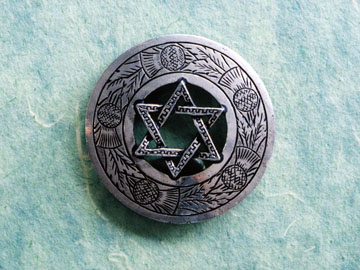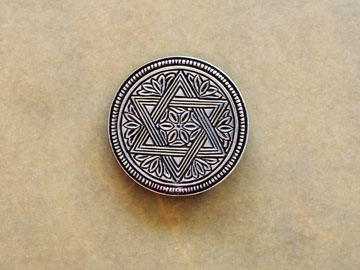|
-
22nd May 08, 11:43 AM
#41
I understand Gilmore's respect for tradition, but, as has been pointed out, and as those of you who have tartans reflecting your actual family names know, nothing feels better than saying, "it's who *I* am."
I have one practical question about the material, though. The issue of the wool not being mixed with linen is highlighted in the news article. Is that actually how kilts are made? If so, what are these made from, and how would they wear, as opposed to standard kilt material?
One correction to that article. There was a thread here a while back which told us about a tartan designed by the abbot of a Buddhist monastery in Scotland. It even comes in two versions: monk and layman. 
-
-
22nd May 08, 11:50 AM
#42
 Originally Posted by Galician

There was a thread here a while back which told us about a tartan designed by the abbot of a Buddhist monastery in Scotland. It even comes in two versions: monk and layman. 
What's the difference - pockets?
-
-
22nd May 08, 11:52 AM
#43
 Originally Posted by Galician

I have one practical question about the material, though. The issue of the wool not being mixed with linen is highlighted in the news article. Is that actually how kilts are made? If so, what are these made from, and how would they wear, as opposed to standard kilt material?
It's not that the typical wool kilt is made that way, but a lot of cloth is made by mixing materials.
I believe there is a Jewish prohibition to wearing clothes of "mixed cloth". By labeling it as non-mixed, it is okay to wear. Someone more knowledgable than I will have to verify that.
We're fools whether we dance or not, so we might as well dance. - Japanese Proverb
-
-
22nd May 08, 12:00 PM
#44
Yes, I'm aware of the prohibition, Dave, but I was trying to find out if it would make any practical difference so far as kilts are concerned.
Btw, the difference in the Buddhist tartan was the coloring, as I recall, with saffron being more predominant in the version used by monks and nuns. I just never caught if they planned to wear kilts in that monastery. 
P.S. doesn't that question about the Buddhist tartan confuse tartan with kilts? 
-
-
22nd May 08, 12:04 PM
#45
 Originally Posted by Monkey@Arms

Until the Slanj pins are found, here are two less-traditional possibilities from Nagle Forge:


Best regards,
Jake
the tartan is nice, but those pins...ESPCIALLY the first one, are really handsome. I bet the ladies in my Klezmer/Celtic band would wear one!
-
-
22nd May 08, 01:43 PM
#46
I mentioned it earlier in the thread. you can't mix wool and linen. That mixture is called shatnes.
Shatnes is not Kosher.
 Originally Posted by davedove

It's not that the typical wool kilt is made that way, but a lot of cloth is made by mixing materials.
I believe there is a Jewish prohibition to wearing clothes of "mixed cloth". By labeling it as non-mixed, it is okay to wear. Someone more knowledgable than I will have to verify that.
-
-
22nd May 08, 02:00 PM
#47
I believe it can be found in Leviticus 19:19.
During The War Between the States, the South made great use of a wool/linen textile. It was called 'jean wool'.
-
-
22nd May 08, 03:21 PM
#48
Actually, if you're into halachic stuff it can be found at:
http://www.star-k.org/cons-abou-shatnes2.htm
Which is more than you would ever want to know about kosher garments.
-
-
22nd May 08, 03:31 PM
#49
Would a wool/polyester mix also be shatnes? Seems like it would.
-
-
22nd May 08, 03:47 PM
#50
From the Kosher Organisation site:
The word shatnes is an abbreviation of three words: Shu, Tvui, Nuz and which describe three different stages in the processing of the wool and linen fibers. Although there are differences of opinion as to exactly which processes are being referred to, most poskim maintain Shu refers to the combing of the raw fiber. is the process of spinning fibers into a thread, Tvui and Nuz refers to the twisting or weaving of the threads into cloth. The Gemorah Nida 61:2 states two opinions whether a material, in order to constitute shatnes forbidden by the Torah, requires all three of the above mentioned processes, or if only one of these processes sufficiently qualifies for a shatnes fabric. Since the Torah expresses and combines these three in the one word shatnes, we follow the opinion that a wool and linen mixture is shatnes, forbidden by the Torah, only if all three processes have been performed in the making of the material.
There is a well known disagreement between Rashi and Rabbeinu Tam with respect to these three processes. Rashi's opinion is that both the wool and linen be combined in their raw states, the two fibers are combed, spun and woven together and form a material that qualifies as shatnes forbidden by the Torah. Rabbeinu Tam disagrees and states that the requirement of , Shu, Tvui, and Nuz and is fulfilled even if the wool and linen are separately combed, spun and twisted and are later combined by weaving or attaching the two together. Thus, according to Rabbeinu Tam, the criteria for shatnes forbidden by the Torah will have been met even if they are attached by as little as two stitches as long as both the wool and linen have each undergone the process of , Shu, Tvui, and Nuz .
Did the Wool-poly blend go through the three steps?
This is why we have Kosher rabbis to tell us what is and isn't Kosher.
-
Similar Threads
-
By emeraldfalconoflight in forum General Kilt Talk
Replies: 9
Last Post: 26th January 07, 06:29 AM
-
By wolfgang in forum Kilt Advice
Replies: 10
Last Post: 27th February 05, 06:41 AM
Tags for this Thread
 Posting Permissions
Posting Permissions
- You may not post new threads
- You may not post replies
- You may not post attachments
- You may not edit your posts
-
Forum Rules
|
|






















Bookmarks